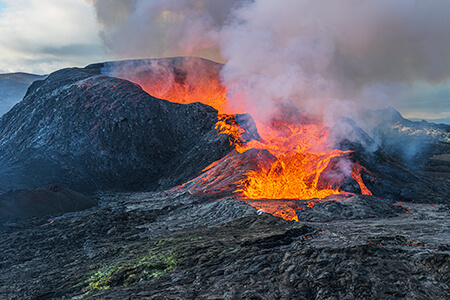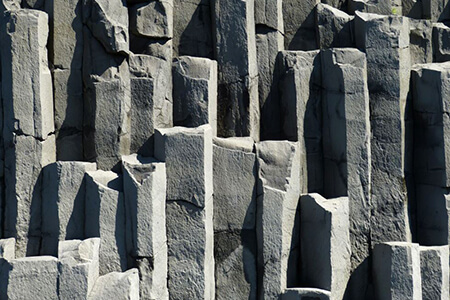This is a lesson summary. The full lesson can be viewed by purchasing an online course subscription.
Learning Objective
In this lesson we will learn about the formation of igneous rocks and compare extrusive and intrusive igneous rocks. We will also look at some common igneous rocks and discuss their properties and uses.
Learning Outcomes
By the end of this lesson you will be able to:
- Explain what igneous rocks are and describe how they are formed.
- Compare extrusive and intrusive igneous rocks.
- Differentiate between mafic and felsic igneous rocks.
- Explain how the appearance of igneous rocks is affected by how quickly they cool during formation.
- Describe some common extrusive and intrusive igneous rocks.
- Discuss some common uses of igneous rocks.

(Image: Marco, Adobe Stock)
Lesson Summary
- Molten rock underneath Earth’s surface is known as magma.
- Molten rock that reaches Earth’s surface is known as lava.
- Igneous rocks are rocks formed from magma or lava that has cooled and solidified.
- Intrusive igneous rocks (plutonic rocks) are igneous rocks formed under Earth’s surface from magma.
- Extrusive igneous rocks (volcanic rocks) are igneous rocks formed on Earth’s surface from lava.
- Igneous rocks are generally very hard and strong due to being composed of hard interlocking crystals.
- Intrusive igneous rocks have larger crystals because they cooled slowly during their formation, which meant that crystals had more time to form.
- Extrusive igneous rocks have smaller crystals or no crystals because they cooled quickly during their formation, which meant that crystals had less time to form.
- Igneous rocks come in a range of colours, depending on their chemical composition.
- Mafic igneous rocks contain dark-coloured minerals that are rich in magnesium and iron.
- Felsic igneous rocks contain light-coloured minerals that are rich in silicon, oxygen, aluminium, sodium, and potassium.
- Granite is the most common type of intrusive igneous rock.
- It is a coarse-grained, light-coloured (felsic) rock that makes up most of the continental crust.
- Basalt is the most common type of extrusive igneous rock.
- It is a fine-grained, dark-coloured (mafic) rock that makes up most of the oceanic crust.
- Due to their hardness and strength, igneous rocks are mostly commonly used as building materials, as whole pieces of rock or as crushed rock.

(Image: PxHere)
(Header image: biletskiyevgeniy.com, Adobe Stock)
